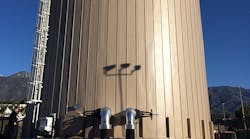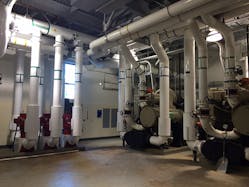Over the last decade, Chaffey College in Rancho Cucamonga, Calif., has added or upgraded more than 400,000 sq ft of building space. As a result, in recent years, the college has made increasing cooling and heating capacity and reducing costs through improvements in operational efficiency a priority.
Chaffey College is served by a central plant consisting of 1,200 tons of cooling capacity provided by two centrifugal chillers and 10,800 MBH of heating hot-water capacity provided by six boilers. To improve operational efficiency and boost cooling and heating capacity, Chaffey commissioned an expansion of the central plant, which was developed under a plan/spec delivery method and executed by an experienced design team: P2S Engineering Inc., the professional of record and provider of all mechanical, electrical, and plumbing engineering services; MHP, which managed all structural design; Froehlich, Kow & Gong Architects Inc., which managed all architectural design; and Southland Industries, the prime contractor. The campus management representative, Bernards, commissioned the project in April 2015, with project completion slated for February 2016.
Equipment Enhancements
With such a large volume of water concentrated in such a relatively small area, the tank’s foundation was important to minimizing settlement. Based on the design criteria, a large ring constructed of 400 yards of 3,000-psi rebar-reinforced concrete was put in place. The foundation involved over-excavation of the site to 5 ft below finish grade and re-compaction of the soil under the tank and around the site.
Upgrades to equipment also included the addition of three new 20-hp primary chilled-water pumps, seven new variable-frequency drives (VFDs), two chilled-water flow meters, and new 14-in. chilled-water piping; the replacement of three 100-hp secondary chilled-water pumps; and controls improvements to support the new sequence of operation and building management system.
Location Selection
Energy efficiency was not the only consideration in the siting of the tank; community aesthetics and simplicity of operation also influenced the decision.
The first location considered would have situated the chilled-water system at the highest water level, avoiding the energy penalty inherent in a back-pressure valve maintaining positive water pressure. Siting the tank high on campus, however, would have had an adverse effect on campus aesthetics. Also, it would have required additional pumps and valves for tank charge and discharge.
The tank was located in a lower, less prominent place, next to the central plant. This made the tank the decoupler between the primary and secondary chilled-water loops and simplified control and operation. The tank’s proximity to the central plant meant a short underground run for the 14-in. chilled-water distribution piping, which minimized trenching costs. The energy penalty comes from the return-water control valve, which modulates to maintain a positive 2-psig pressure in the highest return-piping point in the highest building on campus.
Project Challenges
The only suitable window for shutting down the chilled-water utilities was winter break, Dec. 21, 2015, through Jan. 3, 2016. This required a high level of communication between the construction team and campus personnel. Pull planning was utilized when tie-in activities were scheduled.
Major demolition milestones during this fast-paced shutdown included:
- Removal of the three 100-hp pumps.
- Removal of chilled-water pump headers and distribution piping.
- Removal of VFDs.
- Relocation of electrical/low-voltage panels to support the new equipment.
To increase production and minimize downtime, Southland utilized its prefabrication capabilities for the new 14-in. carbon-steel pump headers and distribution piping, minimizing any welding needed on site. Prefabricating the piping in a controlled environment also allowed for a better product because of increased quality control. Existing structures and utilities were examined to identify clashes with the new system.
Prior to the TES tank being brought online, the water distribution loop was cleaned and flushed. Preventing bacteria growth and contamination of both the tank and corresponding chilled-water distribution piping was of extreme importance to the team and chemical-treatment provider. All nitrites in the chilled water were removed and verified by the campus chemical-treatment provider, and biocide was introduced into the chilled-water system and brought to appropriate levels.
Because of upfront planning, system tie-in was achieved safely and on time and tested prior to the return of the staff and students.
Advantages of Shifting Chiller Load to Off-Peak Periods
There are two primary advantages of chilled-water storage. The first is chilled water is generated when energy prices are lowest and efficiency is highest. This is because lower nighttime temperatures produce lower condenser-water temperatures with less fan energy. The second advantage is the chiller is run at a much more efficient operating point (50 percent or greater) when charging the tank. Additionally, the chiller does not have to operate at low loads, as it can operate off the tank to maintain efficiency.
For Chaffey College, TES is anticipated to provide a shift of 1,149 tons at 0.7 kW per ton, or 804 kW annually. Based on 2012 estimated rates, this is a savings of $18.63 per kilowatt avoided during on-peak hours and $5.22 per kilowatt avoided during off-peak hours. The cost per kilowatt-hour on-peak vs. off-peak represents another savings. Essentially, the TES system is estimated to provide $21,405 in savings per month during summer and well over $100,000 annually.
Energy Incentives
Through its Permanent Load Shifting (PLS) program, Southern California Edison offered an incentive of up to $700,000 for the energy-load shift to off-peak periods of the day.
In addition to the chilled-water scope, the project consisted of upgrades to the heating hot-water system with the installation of six new 1.8-MBH energy-efficient boilers and an additional distribution pump in the existing hot-water plant. The institution received $42,000 from Southern California Gas Co. for these upgrades and additions.
Functional Testing
During functional testing and review of campus trend data, it was discovered that a handful of chilled-water valves located at air-handling equipment were not operating properly, causing the new system to function below target efficiency goals. Identifying this inefficiency allowed the team to make repairs and corrections to maximize operation.
Results
With the cooperation of all involved, the project was completed substantially ahead of schedule and on budget and will result in considerable energy savings. With the rising cost of electricity, shifting chiller operation from on-peak to off-peak periods will continue to yield a return on Chaffey College’s investment, while providing high-quality spaces in which to learn, teach, and work.
Cameron Garnier, PE, CEM, LEED AP, is a project manager for Southland Industries, a national mechanical, electrical, and plumbing building-systems firm. He can be reached at [email protected].
Did you find this article useful? Send comments and suggestions to Executive Editor Scott Arnold at [email protected].











